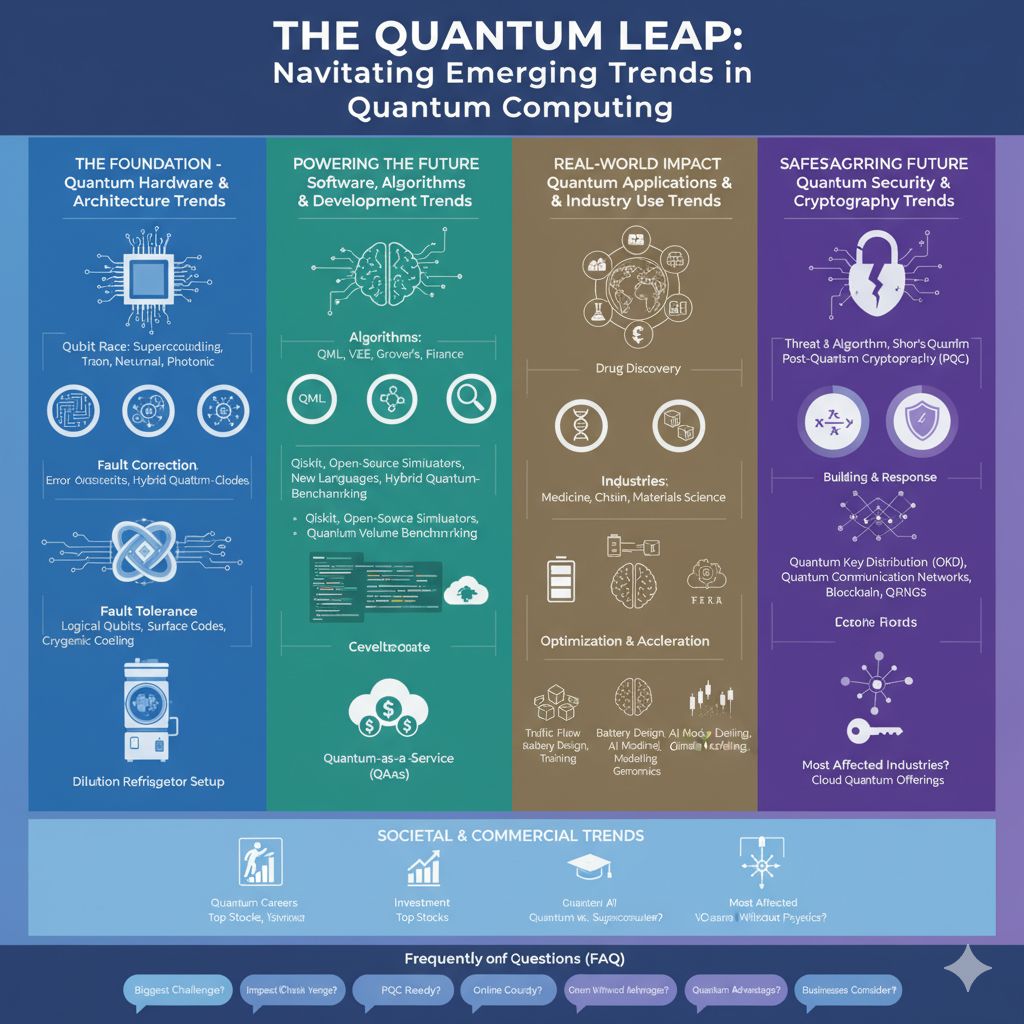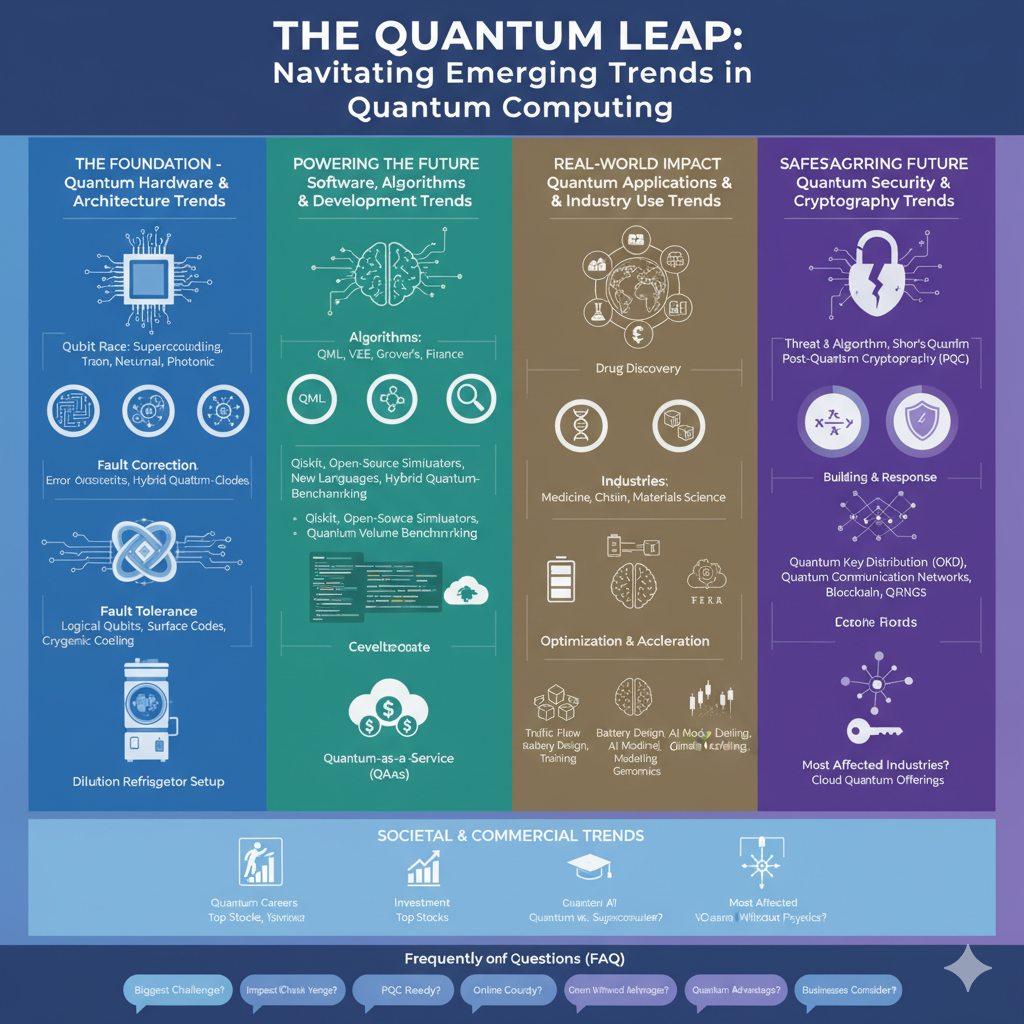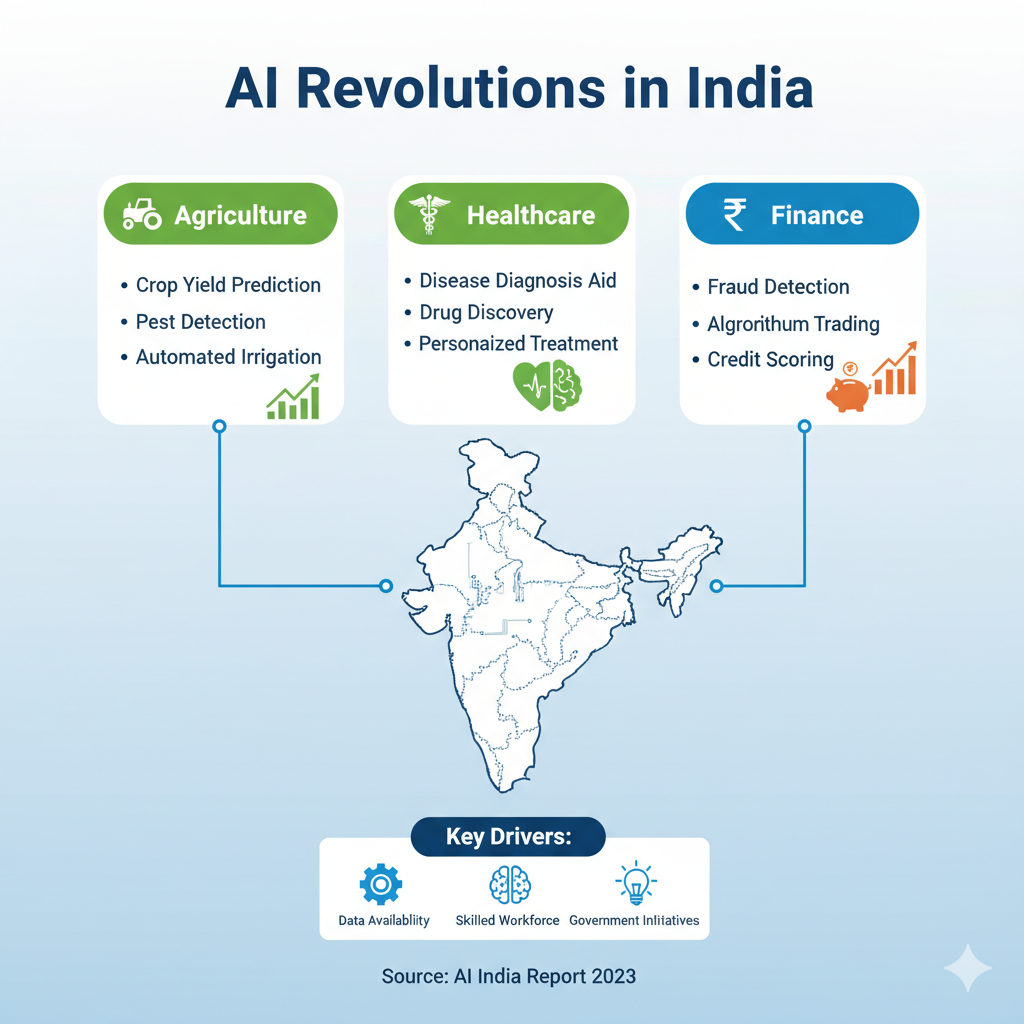
Quantum computing is no longer a futuristic dream; it’s a rapidly evolving field poised to redefine industries from medicine to finance. For businesses, researchers, and tech enthusiasts, understanding the emerging trends in quantum computing is crucial for staying ahead. This advanced guide delves into the intricate world of quantum hardware, cutting-edge software, practical applications, and the vital discussions around quantum security.
The Foundation: Unpacking Quantum Hardware & Architecture Trends
The very core of quantum computing lies in its hardware – the qubits that power these revolutionary machines. Significant progress is being made in the race to build robust and scalable quantum processors.
The Race for Better Qubits: Superconducting, Trapped Ion, and Beyond
Today’s landscape is dominated by a few key qubit technologies. Researchers are relentlessly working to reduce superconducting qubit error rates, which remain a primary hurdle for practical applications. While superconducting qubits offer speed, the comparison of trapped ion vs superconducting qubit scalability is a hot topic. Trapped ions boast longer coherence times and often higher fidelity, making them strong contenders for future fault-tolerant systems, though scaling them presents unique challenges.
Beyond these two, several other promising architectures are gaining traction. Neutral atom quantum computing for beginners explained reveals a fascinating approach that uses individual atoms manipulated by lasers, offering potential for large-scale, low-error systems. Similarly, photonic quantum computing real-world applications are emerging, utilizing photons as qubits, which can operate at room temperature and offer fast communication.
Building Resilience: The Quest for Fault-Tolerant Quantum Computers
One of the biggest obstacles is the inherent fragility of qubits. This leads to the challenges of building fault-tolerant quantum computers. Fault tolerance is achieved through quantum error correction, a complex process that relies on encoding information across multiple physical qubits to form a more stable logical qubit. Understanding how to design a logical qubit using surface codes is a key area of research, as these codes are promising for future architectures.
Supporting these delicate quantum processors requires specialized infrastructure. Think cryogenic cooling systems for quantum processor chips, which maintain temperatures just fractions of a degree above absolute zero for superconducting and trapped-ion systems. For labs and enterprises setting up quantum facilities, a dilution refrigerator setup for quantum computing lab is a critical piece of equipment, enabling the ultra-cold environment needed for optimal qubit performance.
Powering the Future: Software, Algorithms & Development Trends
Hardware is only half the equation; powerful software and ingenious algorithms are what unlock quantum computing’s potential. The development ecosystem is expanding rapidly.
Coding the Quantum Realm: Algorithms and Programming Languages
The best quantum machine learning (QML) tutorials for developers are highly sought after as the intersection of AI and quantum mechanics creates new possibilities. Developers are keen to learn how to run a Variational Quantum Eigensolver (VQE) on Qiskit, a popular IBM open-source framework. VQE is a prime example of a hybrid quantum-classical algorithm, leveraging classical optimization alongside quantum processing to tackle complex problems in chemistry and materials science. Understanding what is hybrid quantum-classical algorithm and its benefits is essential for anyone entering the field, as these algorithms are critical for extracting value from today’s NISQ (Noisy Intermediate-Scale Quantum) devices.
We are still in the NISQ era algorithms and their limitations, where quantum computers have insufficient qubits and coherence to achieve full fault tolerance. However, these devices are already capable of executing impactful algorithms. Learning implementing Grover’s algorithm for database search tutorial can demonstrate how quantum speedup could revolutionize search functions.
The software landscape includes a growing array of tools. Open-source quantum simulators for desktop use allow developers to experiment with quantum circuits without needing access to a physical quantum computer. The future development of quantum programming languages beyond Q# is also exciting, with new languages and frameworks constantly emerging to simplify quantum programming. For measuring progress, benchmarking quantum computer performance using quantum volume has become a standard metric, indicating a quantum computer’s overall capability.
The Rise of Quantum-as-a-Service (QaaS)
Accessibility is being democratized through cloud platforms. Quantum-as-a-Service (QaaS) pricing comparison 2025 will be a crucial factor for businesses looking to leverage quantum capabilities without the immense upfront investment in hardware.
Real-World Impact: Quantum Applications & Industry Use Trends
Where will quantum computing make its mark? The potential applications are vast and transformative, promising breakthroughs across numerous sectors.
Revolutionizing Science and Industry
In medicine, quantum computing for drug discovery and molecular simulation offers unprecedented abilities to model complex molecular interactions, potentially accelerating the development of new pharmaceuticals. For logistics, how quantum algorithms optimize supply chain logistics and routing could lead to massive efficiencies, reducing costs and environmental impact.
Finance is another ripe area. Financial risk analysis using quantum annealing explained reveals how quantum approaches can process complex market data to better predict risks and optimize portfolios. We’re even seeing proof-of-concept for quantum computing for fraud detection in banking case study, showcasing its potential to identify subtle patterns indicative of fraudulent activity.
Optimizing and Accelerating Across Sectors
From optimizing traffic flow management with quantum algorithms in smart cities to the potential of quantum computing in materials science R&D for creating novel materials, the optimization capabilities are staggering. Imagine quantum computing in weather forecasting and climate modeling, providing more accurate long-range predictions. Even AI model training acceleration using quantum processors could push the boundaries of artificial intelligence.
Further applications include using quantum computing for battery design optimization, which could lead to more efficient and longer-lasting batteries for electric vehicles and mobile devices. The future use of quantum computing in genomics and bioinformatics holds the promise of accelerating genetic research and personalized medicine.
Safeguarding the Future: Quantum Security & Cryptography Trends
As quantum computers become more powerful, they also pose significant threats to current encryption standards. This has led to an urgent focus on post-quantum security.
The Post-Quantum Threat and Response
A critical question is when will Shor’s algorithm break current encryption? Shor’s algorithm, if run on a sufficiently powerful quantum computer, could efficiently factor large numbers, thereby compromising widely used encryption methods like RSA. This looming threat necessitates the development of Post-Quantum Cryptography (PQC) standards.
The practical implementation of Post-Quantum Cryptography (PQC) standards is now a top priority for governments and corporations globally. Several nations are issuing government mandates for quantum-safe encryption transition, urging organizations to begin planning their migration. Comparing lattice-based vs code-based PQC algorithms helps in understanding the different mathematical foundations for these new cryptographic primitives.
Building a Quantum-Safe Future
Beyond PQC, what is Quantum Key Distribution (QKD) and how does it work offers a fundamentally secure method of key exchange based on the laws of quantum mechanics. However, there are challenges in building a global quantum communication network that could support QKD over long distances.
The implications for current technologies are profound. Understanding quantum security threats to current blockchain technology is crucial for the crypto industry. Companies will soon need a step-by-step guide to migrating to a quantum-safe infrastructure. Even the cryptography job market in the age of quantum computing is seeing a surge in demand for experts in PQC and quantum security. Further enhancing security are the latest developments in quantum random number generators (QRNG), which produce truly random numbers essential for strong encryption.
Beyond the Tech: Societal & Commercial Trends in Quantum Computing
The quantum revolution extends beyond the labs, impacting education, investment, and societal structures.
The Growing Quantum Ecosystem
For individuals, figuring out how to get started with a quantum computing career path is a common query, reflecting the growing demand for skilled professionals. Investors are keenly watching top quantum computing stocks to watch in 2026, as the market matures. The overall quantum computing market size and forecast 2030 indicates exponential growth, driven by both public and private investment.
The physical infrastructure of our digital world will also change. The impact of quantum computing on data center architecture will involve integrating quantum accelerators alongside classical servers. As with any powerful technology, the ethical implications of quantum AI and its future require careful consideration, ensuring responsible development and deployment.
Investment, Education, and the Quantum Advantage
Governments are playing a significant role through government funding for national quantum research centers, accelerating R&D. Educational institutions are responding with the best university online courses for quantum computing certification, making specialized knowledge more accessible. Venture capital investment trends in quantum startups Q1 2025 show continued strong interest in innovative quantum solutions.
A key milestone for the industry is understanding what is the quantum advantage threshold explained simply – the point at which quantum computers can perform tasks classical computers cannot, or do so significantly faster. Finally, access to these powerful machines is being democratized through public cloud quantum offerings from Amazon, IBM, and Google, allowing researchers and businesses to experiment with quantum computing on demand.
Frequently Asked Questions (FAQ) about Emerging Trends in Quantum Computing
Q1: What is the current biggest challenge in building quantum computers?
A: The current biggest challenge lies in maintaining quantum chip coherence time and reducing superconducting qubit error rates. Qubits are extremely fragile and susceptible to environmental noise, leading to errors and short computational lifetimes. Achieving fault tolerance through robust error correction remains a primary hurdle.
Q2: How will quantum computing impact everyday life in the next 5-10 years?
A: While full fault-tolerant quantum computers are still some years away, we can expect indirect impacts. Quantum-accelerated drug discovery could lead to new medicines faster, improved logistics might mean more efficient deliveries, and advancements in materials science could lead to better batteries or solar panels. Hybrid quantum-classical algorithms are likely to drive these early benefits.
Q3: Is Post-Quantum Cryptography (PQC) ready for widespread implementation?
A: PQC algorithms are under active standardization by bodies like NIST, and early implementations are emerging. While not fully widespread, the practical implementation of Post-Quantum Cryptography (PQC) standards is a major focus, driven by government mandates for quantum-safe encryption transition. Organizations are beginning to plan their migration to a quantum-safe infrastructure.
Q4: What’s the difference between a quantum computer and a classical supercomputer?
A: Classical supercomputers use bits (0 or 1) and rely on brute-force processing. Quantum computers use qubits, which can be 0, 1, or both simultaneously (superposition), and can be entangled. This allows them to explore many possibilities at once, making them suited for specific, complex problems that are intractable for even the most powerful classical machines.
Q5: What are some specific industries that will be most affected by quantum computing trends?
A: Key industries include pharmaceuticals and healthcare (quantum computing for drug discovery and molecular simulation, future use of quantum computing in genomics and bioinformatics), finance (financial risk analysis using quantum annealing explained, quantum computing for fraud detection in banking case study), logistics (how quantum algorithms optimize supply chain logistics and routing), and materials science (potential of quantum computing in materials science R&D, using quantum computing for battery design optimization).
Q6: Can I learn quantum programming without a physics degree?
A: Absolutely! While a physics background is helpful, it’s not a prerequisite. Many resources, including best quantum machine learning (QML) tutorials for developers and best university online courses for quantum computing certification, are designed for computer scientists, engineers, and developers. Platforms like Qiskit and Cirq make it increasingly accessible.
Q7: What is “quantum advantage” and have we achieved it?
A: What is the quantum advantage threshold explained simply refers to the point where a quantum computer can solve a specific problem significantly faster than the best classical supercomputer, or a problem that a classical computer cannot solve at all. While demonstrations of “quantum supremacy” have occurred for specific, often academic tasks, achieving commercially relevant quantum advantage for practical problems is an ongoing goal.
Q8: What should businesses consider when looking into quantum computing?
A: Businesses should assess potential use cases, explore Quantum-as-a-Service (QaaS) offerings, understand the implications of quantum security threats and the need for PQC migration, and consider talent development for their teams. Starting with hybrid quantum-classical algorithms is often a practical first step.



